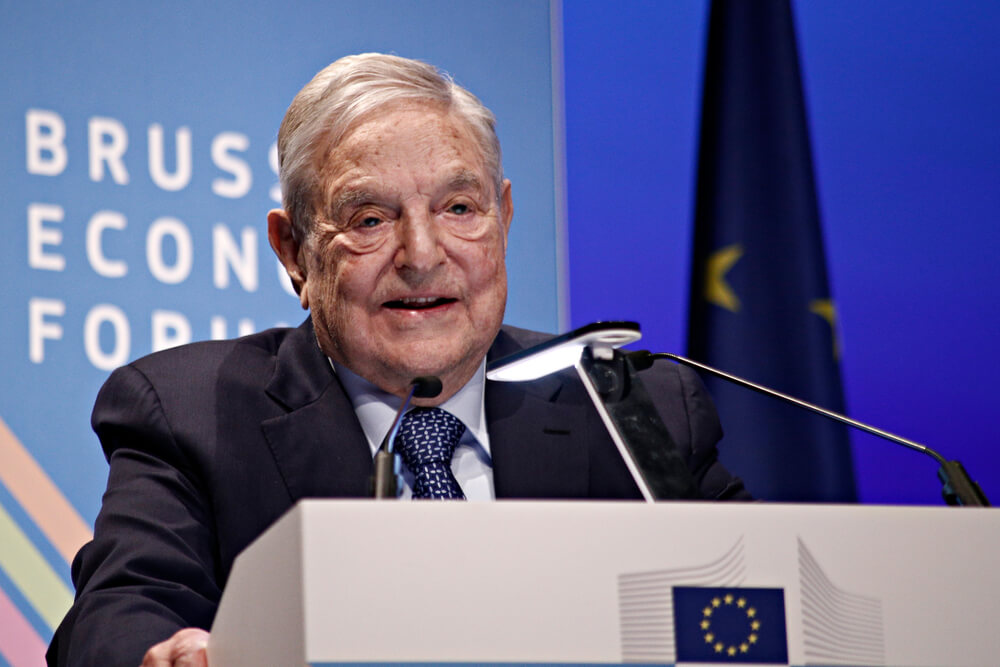When pipe bombs turned up in the mail of Hillary Clinton and other prominent Democrats this week, the first recipient — billionaire investor and liberal philanthropist George Soros — quickly fell out of the headlines.
But there’s no chance his many critics and enemies have forgotten him.
White nationalists and others on the political fringes have long cast Soros as the supposed leader of a globalist Jewish plot to undermine white Christian civilization.
Now, President Donald Trump, Hungarian Prime Minister Viktor Orban and other political leaders have brought the vilification of Soros into the mainstream.
This year, Soros has been accused by critics including Rep. Louie Gohmert, R-Texas, of purportedly funding a caravan of Central American migrants marching toward the U.S.
Others have charged him with hijacking a campaign by Florida high school students demanding gun control. Trump tweeted recently that women who confronted Republican senators about Brett Kavanaugh’s nomination to the Supreme Court were actually professional protesters, paid by Soros.
Profit Alert: Early investors could reap huge profits as this brand new industry surges up to 77,400%
For many on the far right, Soros is “like the Jew behind the curtain, from their perspective, not just in the U.S., but all over the world. He’s the number one enemy of folks on the radical right,” said Heidi Beirich, director of the Intelligence Project at the Southern Poverty Law Center, which tracks U.S. hate groups. “The demonization of sorts has been going for a while, but it has really hit sort of a fever pitch in the last three to four years.”
On Friday, investigators arrested a south Florida man, charging him with carrying out the mail bomb scare, in which no one was hurt. The suspect, Cesar Sayoc, 56, maintained social media accounts promoting conspiracy theories about Soros.
The fact that Soros was a target seemed less a surprise than a logical progression, Beirich said.
In an analysis of millions of anti-Semitic Twitter posts over the year that ended in January, the Anti-Defamation League found that Soros was among the most frequent targets.
Trump has tapped into those sentiments, and several Republican politicians have followed his lead.
“For those who control the levers of power in Washington and for the global special interests, they partner with these people that don’t have your good in mind,” Trump said in the final ad of his 2016 campaign, featuring video of Soros and others.
In an interview last year with Vice News, Rep. Paul Gosar, R-Arizona, suggested that Soros had backed activists behind the 2017 white nationalist rally in Charlottesville, Virginia that turned deadly.
“Who is he? I think he’s from Hungary. I think he was Jewish and I think he turned in his own people to the Nazis. We better be careful about where we go with those,” Gosar said, repeating another right-wing myth about Soros’ past that has been debunked.
The 88-year-old Soros has given more than $32 billion to his Open Society Foundations to fund causes including free debate and government accountability. That spending has fueled countless conspiracy theories. Some of the depictions of Soros draw on bits of truth, while contradicting much of his life story.
“My father acknowledges that his philanthropic work, while nonpartisan, is “political” in a broad sense: It seeks to support those who promote societies where everyone has a voice,” the investor’s son, Alexander Soros, wrote this week in an opinion piece published in The New York Times.
“There is a long list of people who find that proposition unacceptable.”
Soros was born in Budapest in 1930. His family changed their last name from Schwartz to hide their religion from the Nazis, who slaughtered more than 500,000 Hungarian Jews. After World War II, a penniless, 17-year-old Soros left for England and eventually enrolled at the London School of Economics. He embraced the teachings of philosopher Karl Popper, whose ideas about how people interact in open societies helped shape Soros’ beliefs about the need for democracy, as well as the behavior of investors and financial markets.
Soros’ investment strategies and his aggressiveness in acting on them made him one of the world’s most successful traders.
“It wasn’t that he was right more often about which way the dollar was going to go or which way the stock market index is going to go… but when he was right and he had conviction, he put on these enormous bets,” said Sebastian Mallaby, author of “More Money Than God: Hedge Funds and the Making of a New Elite.”
Soros became known as the “Man Who Broke the Bank of England,” for wagering heavily against the British pound in 1992, betting that it was overvalued. When the pound fell sharply, as Soros predicted it would, he made an estimated $1 billion.
Soros moved to the U.S. in 1956 to take a job at a small New York brokerage. He got U.S. citizenship and in 1969 helped launch the Quantum Fund, which delivered stellar returns over more than three decades. In 2011, he announced he was closing the fund to all but family members.
By then, he had become very active in philanthropy, dating to the 1970s when he paid to help black students attend college in apartheid-era South Africa.
In 2014, Forbes estimated Soros’s fortune at $23 billion. But transfers to his foundation have reduced the money he now holds to $8 billion, making him the 190th richest person in the world, the magazine estimates.
“The three parts of George Soros are the philosopher, the speculator and the philanthropist/politician,” Mallaby said, “And they’re all animated by the same belief that you can trigger a cascading change if you are willing to bet enough money to kind of shock the system and start the change.”
In recent years, right-wing populist leaders in Eastern Europe have accused Soros of using his money to force liberal values and refugees on their societies.
While Soros has funded left-wing causes, many of his donations have also gone to causes like improving public health and transportation. Hungary’s Orban was among those who benefited. He received scholarships from Soros in the 1990s to study in the West or conduct research.
During a parliamentary campaign last spring, Orban’s government plastered anti-Soros ads across the country accusing the philanthropist of seeking to transform Europe from a place that is predominantly white and Christian to one dominated by Africans and Muslims. One campaign poster showed a photo of a smiling Soros with the words “Let’s not let Soros have the last laugh.”
Soros has also been denounced in Macedonia and Poland, as well as in Israel, where Prime Minister Benjamin Netanyahu accused him of funding opposition to a government plan to deport refugees.
The repeated attacks on Soros carry the risk that some people might act on that demonization, said Aryeh Tuchman, associate director of the ADL’s Center on Extremism.
Tuchman pointed to a 2010 shootout between police and a California gunman who set out to kill people at a foundation partially funded by Soros because he thought the billionaire was responsible for the Deepwater Horizon oil spill. That gunman pointed to a conservative television commentator’s diatribe against Soros.
“There are crazy people out there, for lack of a better word, people inclined toward extremism, inclined to act out based on the ideas that they hear,” Tuchman said. “And to the extent that there is this drumbeat of anti-Soros conspiracy mongering and demonization, it is not shocking that once in a while that someone takes that one step further.”
© The Associated Press. All rights reserved.




